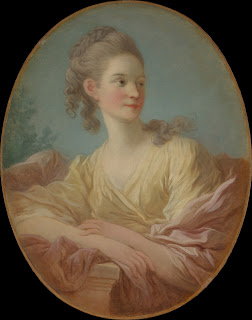The portrait: a classic, well-renowned category of painting. But how do art historians and viewers alike define what is portraiture and what is genre scene? Rococo artist Jean Honoré Fragonard’s extensive collection contains paintings from across the spectrum. His mastery of technique allows him to paint works ranging from classically unique portraiture to erotic genre scene and even detailed landscape. Cinematic compositional choices and clever thematic elements allow viewers to differentiate between these classifications. His euphoric, vigorous painting techniques allow for a light-hearted viewing experience, but also serve as visual markers for the trained eye. The following six paintings reflect the playful and erotic themes that present themselves in Fragonard’s work but also provide an important visual comparison and contrast between his portraiture and genre work. As you view, take a closer look at the figures in each painting. Notice their features and outfits as well as the space they consume in the composition. Consider different spotlights presented with compelling, theatrical gusto. Examine the ways different figures seem to stare back at and invite you a little closer to their worlds. Proceed with caution as we take a trip through this romantic and inviting world of Jean Honoré Fragonard’s fantasy figures and playful genre work.
The Love Letter, Jean Honoré Fragonard, early 1770s
Oil on canvas, 32 3/4 x 26 3/8 in. (83.2 x 67 cm), The Met 49.7.49
Portrait of a Young Woman, Jean Honoré Fragonard , 1770s Oil on canvas, Oval, 31 3/4 x 25 in. (80.6 x 63.5 cm), The Met 65.226
A Woman with a Dog, Jean Honoré Fragonard, ca. 1769 Oil on canvas, 32 x 25 3/4 in. (81.3 x 65.4 cm), The Met 37.118
The Bolt, Jean Honoré Fragonard, ca. 1778 Oil on canvas, 93 x 73 cm, Louvre, Paris, France
A Young Girl Reading, Jean Honoré Fragonard, ca. 1776 Oil on canvas, 64.8 x 81.1 cm, National Gallery of Art, Washington, DC, US
The Swing, Jean Honoré Fragonard, 1767 Oil on canvas, 64.2 x 81 cm, Wallace Collection, London, UK
One of Fragonard’s most famous works of art, this painting still uses the imagination to create a sense of fantasy. The defined, linear quality of this painting contrasts much of what we have seen from Fragonard’s genre and portrait work previously. However, this is still a romantic, playful moment between two lovers. Rather than the viewer invading this moment, we get to relax and watch the tension between the man pushing the swing and the younger man peering at the young damsel in the center of the composition.






No comments:
Post a Comment